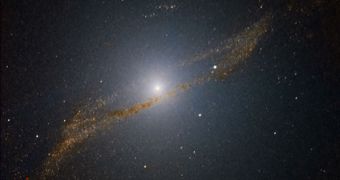Centaurus A is a very active galaxy, whose core is currently producing a large number of stars. It is believed that, 200 to 700 million years ago, it collided with another similar structure, which it consumed. The remains of that galaxy are still being ground down in the core of the former, triggering a large number of peculiar phenomena, in addition to intense stellar formation. Currently, Centaurus A is at it again, cannibalizing a smaller spiral galaxy, which is already twisted, warped and bent by the massive gravitational interactions that occur between the two, LiveScience reports.
At the core of Centaurus A is a supermassive black hole, with 200 million times the mass of our Sun, and roughly 50 times the mass of the black hole at the core of our own galaxy, the Milky Way. The structure is not far away from us. The entire galaxy is located just some 11 million light-years away, which in fact makes it one of our closest neighbors. The elliptical structure is currently gobbling up its newly found meal, which some astronomers believe it may be its last.
A recent set of astronomical observations have allowed astrophysicists to look deep into the most obscured areas of Centaurus A, where the most massive amounts of dust are found. The studies were performed over a number of years, using the European Space Agency's (ESA) Infrared Space Observatory (ISO), as well as NASA's Spitzer Space Telescope. ISO discovered the remains of the first meal, in the form of a 16,500 light-year-wide structure at the core of Centaurus A. Spitzer later found that this formation was shaped like a parallelogram.
According to a mounting group of evidence, giant elliptical galaxies such as our neighbor are formed mostly through galactic merging, also known as galactic cannibalism. The newest images were taken by the European Southern Observatory's (ESO) 3.58-meter, La Silla, Chile-based New Technology Telescope (NTT). All of the structures inside the galaxy were observed in amazing detail, and free of surrounding dust. Centaurus A thus revealed some of its mysteries, which surprised astronomers.
“There is a clear ring of stars and clusters hidden behind the dust lanes, and our images provide an unprecedentedly detailed view toward it. Further analysis of this structure will provide important clues on how the merging process occurred and what has been the role of star formation during it,” explains the lead author of the new study, Jouni Kainulainen. “These are the first steps in the development of a new technique that has the potential to trace giant clouds of gas in other galaxies at high resolution and in a cost-effective way. Knowing how these giant clouds form and evolve is to understand how stars form in galaxies,” says Joao Alves, a coauthor of the research.

 14 DAY TRIAL //
14 DAY TRIAL //